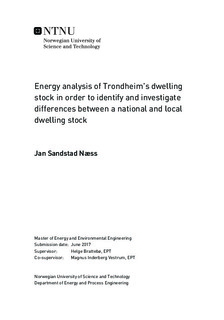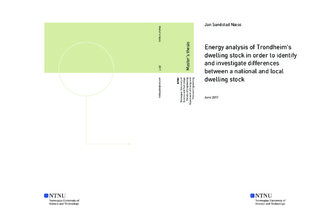| dc.description.abstract | The European Union has set ambitious targets for 2020 known as the 20/20/20 targets aiming to reduce greenhouse gas emissions by 20%, increase the share of renewables to 20% and improve energy efficiency by 20%. Buildings represents 40% of the final energy use in the EU and has a large potential for contributing to these targets by implementing energy efficiency measures. Refurbishment of aging buildings together with the implementation of better solutions for energy performance becomes important.
Often policy roadmaps use detailed information on energy and emission intensities, but lacks detailed information about the building stock itself. Renovation rates are often assumed to be easily increased by policy makers, but studies have shown that renovation rates are highly dependent on stock composition. As building stocks consists of different building types and age cohorts the potential for improved energy efficiency will vary due to changing technologies and building codes in the past. The energy characteristics and dynamics of the national dwelling stock of Norway has been investigated in previous studies. However, it is likely that the dwelling stock on a local scale could be of a different nature than the national average and that the local dwelling stock energy characteristics could differ from the national average. A regionalization of a dwelling stock model to develop specialized regionalized energy policies could prove to be of importance to local legislators, businesses and stakeholders.
This MSc thesis models the energy use from the Norwegian city of Trondheim s dwelling stock by using a regionalized segmented dynamic stock model. Statistical data has been gathered for the period of 1800 to present day, combined with population forecasts and implemented into the model. A detailed energy analysis has been run on Trondheim s dwelling stock based on stock composition and corresponding parameters for sub segments, archetypes and cohorts such as average heated floor area, energy intensities, energy mix and system efficiencies. Four possible future scenarios in addition to the business as usual scenario has been analyzed. The results suggest that the composition of Trondheim s dwelling stock differs from the national stock. The energy characteristics has also been shown to differ from the national average.
Trondheim s dwelling stock has been shown to have a larger share of Multi Family Houses than the national average. Additionally, the stock has a larger share of older dwellings. A future dwelling stock growth is expected. The energy analysis has shown that Trondheim s energy mix differs from the national average with a higher share of district heating. Historically, Trondheim s energy intensity has also been lower than the national average. Through the scenario analysis a roadmap giving possible future energy characteristics for Trondheim s dwelling stock has been created.
Baseline results suggests that even though the dwelling stock is expected to increase the delivered energy to the system is expected to experience only minor growth. However, the potential for future energy savings is large. In the most optimistic scenario a 37% decrease of delivered energy in 2050 compared to present day is expected. Somewhat surprisingly it has been shown that the potential for energy efficiency measures through advanced and more frequent renovation is limited. This is due to that much of the possible gains will be reached anyway before 2050 through natural standard renovation. However, an extensive policy of local energy use by using HPs and PVs has proven to be very effective and represents the largest opportunity for energy savings towards 2050. Moreover, it has been shown that there is a large potential to shift the current energy mix in the city to a larger share of district heating in 2050. This could represent an opportunity to free surplus electricity that can then be used to replace more carbon intensive energy carriers in other sectors. For instance, by powering a future electrical vehicle park with electricity.
It has been shown that it will also be important in Trondheim as found for the whole country by Sandberg et al. (2017) to make efforts to limit the expected rebound effect. As the theoretical estimated energy need intensity decrease in the stock a change in user behavior is expected to counteract the improved energy efficiency through a higher energy use. This will limit the potential for energy savings in the stock and policies should be created to minimize this change in user behavior.
The findings suggest that regionalized dwelling stock models will indeed be of great use for local policy makers. It has given much needed insight into Trondheim s dwelling stock composition. The model s ability to assess the stock s energy mix on a per type, cohort and archetype level has proven to be of key use when assessing the potential for district heating in Trondheim. Through a scenario based energy analysis of a segmented dynamic dwelling stock model different possible energy policies can be compared and tested against each other on a long-term scale. | |

